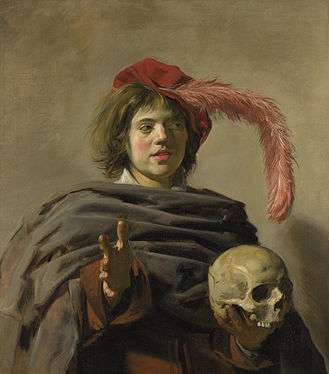Young Man with a Skull
|
Young Man with a Skull, c.1626 Oil on canvas, 92 x 81 cm | |
| Artist | Frans Hals |
|---|---|
| Year | 1626 |
| Catalogue | Seymour Slive, Catalog 1974: #61 |
| Medium | Oil on canvas |
| Dimensions | 92 cm × 81 cm (36 in × 32 in) |
| Location | National Gallery, London |
| Accession | NG6458 |
Young Man with a Skull is a painting by the Dutch Golden Age painter Frans Hals, painted in 1626 and now in the National Gallery, London. The painting was previously labelled Hamlet holding the skull of Yorick.
Painting
The painting shows a young man in a feathered bonnet gesturing and holding a skull, and was first documented by Hofstede de Groot in 1910, who wrote "HAMLET - Half-length. A youth faces the spectator. His head is slightly inclined to the right, and he looks in the same direction. His right hand, much foreshortened, is stretched out to the front. In his hand he holds a skull. He has long unkempt hair, and wears a red cap with a long plume hanging down on the right. His big cloak is fastened across his breast; a piece of his white collar and of the lower opening of the sleeve are also visible. Light-grey background. Life size. Exhibited on loan in the Dublin National Gallery, 1895."
Hofstede de Groot noticed this painting's similarity to another painting by Hals, and he remarked that the subject's right hand "formerly rested on a skull which has been painted out". Later its title indicating a theatrical portrayal of Hamlet was called into question by W.R. Valentiner in 1923. In his 1989 catalog of the international Frans Hals exhibition, Slive claims it is a vanitas and compares it to several other examples of men portrayed with skulls. He rejects the idea of Hamlet because Shakespeare's plays have not been recorded in the Northern Netherlands in the 1620s.[1]
The National Gallery (UK) writes, "The skull held by the boy is a reminder of the transience of life and the certainty of death. Such a subject is known as a 'Vanitas' (Latin for vanity), ... The Netherlandish tradition of showing young boys holding skulls is well-established and can be traced back to engravings of the early 16th century."[2]
Hals' dress of the figure holding a skull with a draped cloak over the chest is similar to at least four other known paintings:
- Boy in a feather hat by Frans Hals (skull is painted out)
 Self portrait by Michael Sweerts (skull was previously painted out)
Self portrait by Michael Sweerts (skull was previously painted out) Self portrait by Jan Miense Molenaer
Self portrait by Jan Miense Molenaer Old man with a skull, by Jan Lievens
Old man with a skull, by Jan Lievens
See also
References
- ↑ Frans Hals, by Seymour Slive as editor, with contributions by Pieter Biesboer, Martin Bijl, Karin Groen and Ella Hendriks, Michael Hoyle, Frances S. Jowell, Koos Levy-van Halm and Liesbeth Abraham, Bianca M. Du Mortier, Irene van Thiel-Stroman, page 208, Prestel-Verlag, Munich & Mercatorfonds, Antwerp, 1989, ISBN 3791310321
- ↑ "Young Man holding a Skull (Vanitas)". National Gallery. Retrieved 13 April 2015.
- Hofstede de Groot on two paintings of young men with skulls (one painted out); catalog numbers 102 & 103
External links
- blog about 'Young Man with a Skull'
- 'Young Man with a Skull' on website National Gallery
- Information in the Web Gallery of Art

